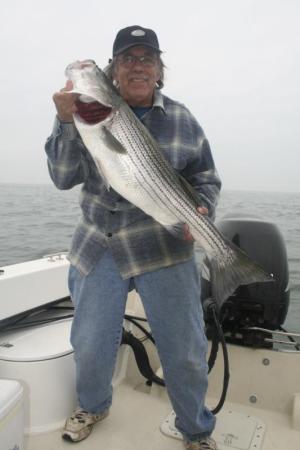I have been following striped bass since the early 1970s, when I met Bob Pond and Avis Boyd at a fishing show. They explained that striped bass were experiencing poor reproduction in the Chesapeake Bay, and Bob thought that was because the eggs that the females carried were of poor quality. He would go to spawning sites such as the Nanticoke River and collect eggs and study them under a microscope. According to his results, those eggs were not capable of producing healthy fish.
Of course, the scientific community wrote him off as a crackpot, but that did not deter Bob one bit. He continued to yell fire, and while the egg quality may not have been the reason for the poor reproduction, he was correct that the striped bass were in serious trouble.
As the young of the year numbers in the Chesapeake Bay continued to fall and the number of adult striped bass followed suit, the scientific community finally took notice. A committee of one recreational fisherman, one commercial fisherman and one scientist from each state from Maine to North Carolina was formed to try to find a solution to the striped bass problem. I represented Delaware recreational fishermen, and by the time we were done, there was a moratorium on striped bass until the young of the year numbers improved in the Chesapeake Bay.
Today, there is another drop in the young of the year numbers in the Chesapeake Bay. The reason for this drop may have more to do with global warming than anything else.
My friend Gary Caputi describes the number of striped bass in the Raritan River and its tributaries as tremendous. He has records that include fish to 25 pounds that were available all the way up to New Brunswick. Gary has fished this region for 40 years, and this is the best action he has ever seen.
I have other friends who run charters on Raritan Bay, and they carry two parties a day. They look for breaking fish feeding on huge schools of menhaden and then cast to them. Most anglers use plugs or bucktails, but fly fishermen also do well. My son Roger gets in on the action trolling plugs from his kayak.
Gary believes the scientific world needs to look at the young of the year numbers from the Hudson River stock. With more and more females moving into the Hudson and its tributaries, such as the Raritan River, he thinks, and I agree, that river system has got to be producing a substantial number of young of the year striped bass.
So why are these females moving from the Chesapeake Bay to the Hudson River? Could it be that the ocean is becoming warmer than they like and they prefer cooler water farther to the north? I have no idea, but I do know we are catching warm-water fish in Delaware that we have never caught before. Triggerfish, spadefish, cobia, Spanish and king mackerel. Cold-water species, such as black sea bass, are moving north.
North Jersey has seen excellent striped bass fishing in the spring and fall, while we here in Delaware have seen some very slight action from big fish as they pass by. This past winter we had a few big stripers caught in January after most anglers had put up their boats for the season. Cape May, N.J., seemed to have the best action, as the fish held there before heading straight for North Carolina.
Or did they go to North Carolina? Recent tagging programs have shown some big stripers tagged off New York and New Jersey go as far east as the Hudson Canyon, then move to Nantucket Shoals before heading back to the Chesapeake Bay. The most recent tagging was at the mouth of the Chesapeake Bay, where the stripers hang out near Cape Charles. I will be very interested in the information received from that tag.
For many years, we believed that striped bass moved in a certain way. They spawned every spring in the Chesapeake Bay and its tributaries, then the females left the bay and moved up the East Coast to New England, where they spent the summer. Other spawning areas such as the Delaware River, the Hudson River and Roanoke River had small spawning numbers.
Now we have new information from satellite tags that proved some big stripers venture far from the coast, and perhaps global warming is changing the behavior of the species completely.
Man is always trying to put nature in small boxes that he can understand. Mother Nature is not going to cooperate. She is going to move on her own without any regard to what man wants.




















































